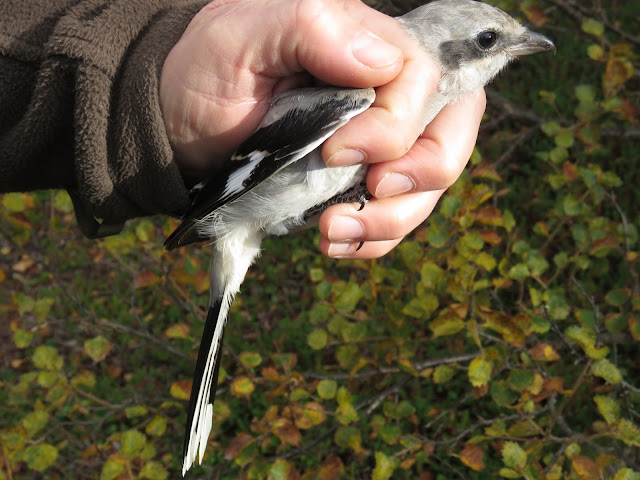continuing the theme of subspecies, morphs and all that malarkey, I thought I'd introduce another factor that could make your birding experience evermore exciting!
Everyone likes Shrikes; they have stunning plumes and an unusual habit of hoarding their prey; they're relatively easy to identify too - or are they?
While out in Norway we managed to chance upon three Great Grey Shrikes, an adult and two 1st years. Unfortunately I lost the pictures of the adult bird but am still able to study the other two birds in detail. I managed to ring both an adult and juvenile and feel extremely lucky to do so, thanks to Nigel and the team's kindness.
Anyway the first juvenile we caught was a typical ssp excubitor, exhibiting diagnostic tail pattern and limited white in secondaries along with the typically darker/colder feel. Bear in mind the photos I am attaching have not been edited in order to give better appreciation of tones rather than making it look nicer; that's science!
Note black shafts in outer tail feather and black extending halfway down the second outermost tail feathers. At the time I forgot to ask for Nigel to spread the wings to get a photo of the rump since it is an identification feature; white is suggestive of homeyeri (the eastern race from Black Sea west to Siberia); grey is suggestive of excubitor (our most common race). It would be good of me to source imaging of genetically identified bird's tails, however I think it's best for you - if you're as keen as me on the topic.
In this photo the important feature is to recognise the scarcity of white in the secondaries (that feather group being the the three white 'teeth' to the middle left of the wing then left of that are the rest). In a typical homeyeri you should see a large white patch similar to the primaries creating a large white wing bar effect. However, with many subspecific groups, intergrades should be taken into consideration with some showing intermediate characteristics relating to their birth (most likely) being between the allegedly clear-cut groups.
I used this photo for to pick up jizz and general feel of the bird, which is most important for those of you that bird rather than ring. Although the photo is slightly over exposed you should make out the dusky grey plumage with the white patch in the primaries being forefront, while the secondary patch is barely visible. I may add that the most diagnostic feature is tail and is diagnostic; things such as secondaries, grey colour and rump are only pointers. Secondaries are useful for telling if they're intergrades rather than true subspecies, unless it's some sort of galliae' type bird.
This picture is of no scientific note (more insanely satisfying, look at that bill!), however it shows the buffier, more diffused pattern that you'd expect with a juvenile bird.
Right so here's the catch. Finally Biff :P The final Great Grey Shrike (I like that line proves we caught more than one: wow) was of more interest and instantly grabbed my attention both when it nearly ripped my finger off in the net but also because of its wing.
Here is the bird:
Now what should 'grab' you is the 2 large white patches; fundamentally the uppermost one since these are the secondaries. Now if you compare it to the original bird.
See what I mean now? Furthermore, in retrospect, it also appears paler even though the shot of the previous bird is considerably overexposed. It also presents a nice WHITE rump; all these fatures are leading to one answer, aren't they? Homeyeri. So why don't we check the most important feature, the tail.
NO! The tail is clearly the same as the previous bird's; take a look:
Exactly the same. So what now? You ask.
Well here's the interesting part - for me at least - and for those who have managed to read this marathon. Hitherto I hadn't realised birds such as this existed I therefore RTFB as the group said AKA read the F****ng book! I was enlightened to hear of a form (not subspecies remember) called 'galliae". This bird is supposedly known to posses large amounts of white in the wing(secondaries in particular) yet still have excubitor tail pattern. Wow, we're getting somewhere here. Now, now though, I haven't got any experience with these (and whether they're a thing is debatable) and there appears to be a lack of text on this subject, therefore I would tentatively leave it as possible; for if you were to be so confident you'd only be let down - well at least that's my experience.
Here's the wing for those like me, itching to see it.
Loads of white again in the secondaries but again look at that white rump. This picture is far more representative too since it isn't overexposed like previous shots. First bird for comparison again.
Only tiny little teeth in the secondaries.
After reviewing (just this minute while typing up now) I would also like to highlight moult. The first bird is already moulting suggesting it is an older bird; bred earlier on this year. Now if you have any experience with eastern taxa in ornithology, it is a common occurrence for eastern birds (like Caspian Gull) to moult quicker linking to seasons. Now like me you may at first take this with a pinch of salt, however I think it could be something to bare in mind, even though it could just be because it was simply an earlier brood.
AHHH... So there you have it, hope you managed to take it all in; I'm struggling at this end mind!




















































